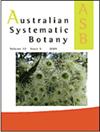Colpomenia species from south and south-eastern Australia (Ectocarpales, Phaeophyceae): a DNA barcoding approach
IF 1.6
3区 生物学
Q4 EVOLUTIONARY BIOLOGY
引用次数: 1
Abstract
Abstract. Defining species in the brown algal genus Colpomenia is a challenging endeavour because of their morphological similarity, overlapping phenotypic variation, the absence of conspicuous diagnostic characters, and often lack of reproductive structures crucial for their identification. Thus, the use of molecular tools has become widely used to study Colpomenia taxonomy and evolution. The following four Colpomenia species are described along the Australian coast: C. claytoniae M.Boo, K.M.Lee, G.Y.Cho & W.Nelson, C. ecuticulata M.J.Parsons, C. peregrina Sauvageau, and C. sinuosa (Mertens ex Roth) Derbès & Solier. The objective of this study was to assess the diversity of Colpomenia species in southern and south-eastern Australia by using DNA barcoding techniques and single-marker species delimitation methods. We generated 44 new COI-5P DNA sequences from nine different populations across three Australian states (South Australia, Victoria and Tasmania), and applied 13 variations of four species delimitation methods (ABDG, SPN, PTP, GMYC). Our results recognised three Colpomenia species in the region, namely, C. sinuosa, C. claytoniae, and C. peregrina. Colpomenia sinuosa is the most widely distributed species in Australia. Colpomenia peregrina and C. claytoniae presented high levels of intraspecific genetic divergence. We did not find C. ecuticulata, although it has been previously reported from nearby our sampling area.澳大利亚南部和东南部的水蛭属植物(石竹科,石竹科):DNA条形码方法
摘要定义棕藻属的物种是一项具有挑战性的工作,因为它们的形态相似,重叠的表型变异,缺乏显著的诊断特征,并且通常缺乏对其识别至关重要的生殖结构。因此,分子工具的使用已被广泛用于研究水蛭属植物的分类和进化。以下四种粪门属在澳大利亚海岸被发现:C. claytoniae M.Boo, K.M.Lee, G.Y.Cho & w.l nelson, C. ecuticulata m.j.s parsons, C. peregrina Sauvageau和C. sinuosa (Mertens ex Roth) derb & Solier。采用DNA条形码技术和单标记物种划分方法,对澳大利亚南部和东南部的水蛭属植物物种多样性进行了研究。我们从澳大利亚3个州(南澳大利亚州、维多利亚州和塔斯马尼亚州)的9个不同种群中获得了44条新的COI-5P DNA序列,并应用了4种物种划分方法(ABDG、SPN、PTP、GMYC)的13种变体。结果表明,该地区存在3种粪菌属,分别为C. sinuosa、C. claytoniae和C. peregrina。sinuosa是澳大利亚分布最广的一种。游隼鸟和克莱顿鸟表现出高度的种内遗传分化。虽然以前在我们的采样区附近有过报道,但我们没有发现锥虫。
本文章由计算机程序翻译,如有差异,请以英文原文为准。
求助全文
约1分钟内获得全文
求助全文
来源期刊

Australian Systematic Botany
生物-进化生物学
CiteScore
3.10
自引率
12.50%
发文量
12
审稿时长
>12 weeks
期刊介绍:
Australian Systematic Botany is an international journal devoted to the systematics, taxonomy, and related aspects of biogeography and evolution of all algae, fungi and plants, including fossils. Descriptive taxonomic papers should normally constitute a comprehensive treatment of a group. Short papers on individual species and nomenclatural papers must contain significant new information of broader interest to be considered. The prestigious L.A.S. Johnson Review Series is published. Other review articles will also be considered. All papers are peer reviewed.
Australian Systematic Botany is published with the endorsement of the Commonwealth Scientific and Industrial Research Organisation (CSIRO) and the Australian Academy of Science.
 求助内容:
求助内容: 应助结果提醒方式:
应助结果提醒方式:


